How to Stop Comfort Eating: Dossier Special
Are you an emotional eater? In this special dossier on comfort eating, learn how to take the emotion out of your relationship with food and nourish yourself, without self-sabotage and guilt...

Part One: Get to grips with your emotional eating
The day went downhill fast. The spiral started when I reached over to pop a jug of porridge into the microwave, an action that somehow knocked over a canister of teabags from a shelf. It landed upside down inside the jug. Breakfast and a mass of teabags ruined! That set the tone and it snowballed from there – missed trains, fraught deadlines and a vexing phone call with a friend. The only thing that kept me going was the prospect of a lovely glass of merlot and some cheese when I finally got home.
It’s likely that this scenario, possibly with different ingredients, is familiar to many, particularly since lockdown. A survey found that the pandemic has caused people living in Britain to become the biggest comfort eaters in Europe, with a 29 per cent rise in alcohol consumption and a similar spike in spending on convenience foods – and even more on a category called ‘tasty treats’. With statistics like these, it’s no surprise that a study by King’s College London found that almost half of us have gained weight since Covid hit.
This could be expected given the stress and boredom that characterised lockdown for many people. With limited activities and little to look forward to, it was all too easy to cheer ourselves up with croissant breakfasts, chocolate biscuits for elevenses and sticky toffee pudding and salted caramel ice cream for dessert every night as a reward for making it through yet another day. But what exactly is it about food that gives us comfort, particularly those items that we are fully aware are not good for us? Rationally, it doesn’t make any sense. Most of the time, I am pretty healthy (see aforementioned porridge), I walk a minimum of 10,000 steps a day and love going to the gym. But I also know that my cake intake probably went up by 30 per cent during lockdown.
Pleasure principle
A major factor is the physiological impact of sugar, often a component of comfort food. As psychologist Cinzia Pezzolesi explains: ‘During lockdown, we were all searching for ways to feel good. Sugar has a strong effect on the brain – it stimulates the reward system. When we eat, say, an ice cream, we produce a hit of dopamine, the feelgood brain chemical. Humans evolved this mechanism because we needed to remember where we found food that was not poisonous.’ Unfortunately, our primeval brains have not caught up with the fact that the corner shop is usually a safe bet for non-poisonous fruit and nuts! The brain learns to produce dopamine every time you eat a food that you find enjoyable to eat.
‘On a day when you feel sad, or even just a bit flat, you reach for the comfort food because you crave those chemicals,’ Pezzolesi says. ‘But what happens as time passes is that the brain generalises that feeling. So, one day, you feel sad and the brain remembers that eating something delicious makes you feel better. That starts the craving cycle. But, over time, you don’t even need to feel low to crave the food – all you need is to see the item and it’s linked to the memory of feeling good. You see it and you want to eat it.’ This explains why someone might always buy a cake when they walk past the patisserie, regardless of whether they are hungry, let alone feeling blue.
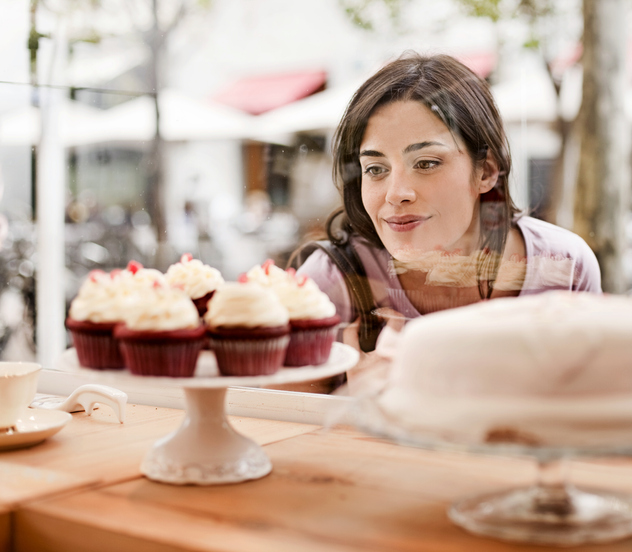
Under pressure
Stress can also trigger comfort eating. A study published in The American Journal Of Clinical Nutrition found that women suffering from work-related stress were more likely to eat when feeling anxious or depressed. ‘Stress destabilises our sense of safety. When we don’t feel safe or well, we are conditioned to believe that food will help us, and we end up stress eating,’ says Pezzolesi. ‘Another reason we eat when we feel overwhelmed is that it’s a form of procrastination. If you’re facing a difficult task you don’t want to do, food provides an escape. You can’t face the task but, by eating, you are still doing something rather than nothing, and you can justify it by telling yourself that you need to eat anyway.’
We knew it all along
The tendency to turn to food for comfort is rooted in unhelpful messaging we may receive in childhood. ‘As babies, we are born with great instincts about food,’ says nutritionist Laura Thomas, author of How To Just Eat It (Pan Macmillan, £14.99).
‘My baby isn’t in his high chair worrying about the calories in a banana. He’s kicking his legs with joy. When he’s finished a meal, he throws the rest on the floor. He knows when he’s full.’ But messages around food, such as ‘you can’t go out to play until you’ve eaten your broccoli’ or ‘if you pass the test, I’ll buy you a sweetie’, reinforce the idea of food as punishment or reward. ‘We need to get rid of the guilt, shame and judgment we have acquired around food and our bodies,’ says Thomas. ‘We cannot unlink emotions from food – all eating is emotional eating if you think about it. We are humans, we have emotions and we have to eat. Neither can we turn off our emotions while we eat.’ Thomas believes that we need to return to a less complicated way of eating. ‘Although different foods have different nutritional values, we should start viewing everything as neutral, rather than morally good or bad. Using terms such as “junk food” is setting ourselves up for a loaded experience. It highlights the message that if you eat it, then you are an unworthy person. It’s ludicrous, it’s just food.’
London Centre for Intuitive Eating
“Are you judging yourself for eating a slice of cake or a pizza? Neutralise the phrases you use about food. Eliminate the good-bad dichotomy”
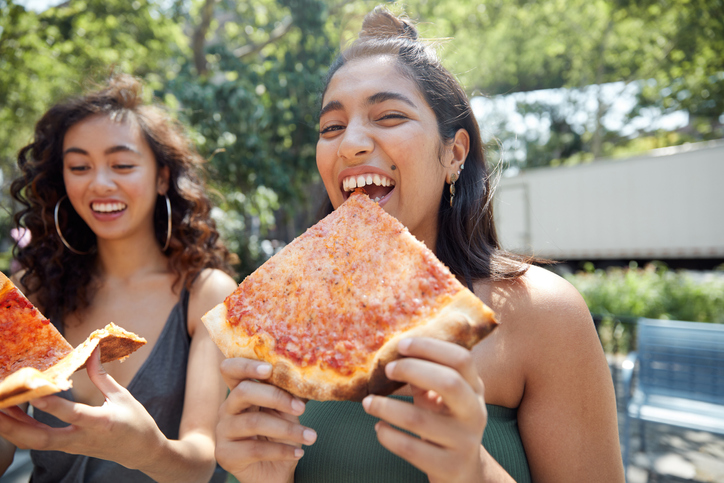
Part Two: Are you an emotional eater – or just hungry?
For anyone who views their diet in terms of ‘good’ and ‘bad’ foods, there may be an unexpected underlying cause for their tendency to scoff a family-sized trifle in front of the TV of an evening, despite their best intentions.
‘Very often, someone will come to me for help with comfort eating or stress eating, whatever they want to label it,’ says nutritionist Laura Thomas. ‘And they will typically mention their daily food diary – they might skip breakfast because they were in a rush, then have a salad for lunch because they were being “good”, then hit the gym after work. By the time they get home, they’re raiding the fridge and eating everything in sight. It’s chaotic and stressful but what they are describing isn’t emotional eating – it’s hunger!’
If you restrict calories and deprive yourself of the things you really want to eat, no wonder you’re tempted to reach for sugary foods at the end of the day. ‘It’s the equivalent of letting the petrol tank in your car run right down – until you’re running on fumes. When it gets that low, the natural response is to fill it back up to full,’ she says.
Thomas suggests that we pay close attention to the language we use around food, particularly words that involve guilt or shame. ‘Are you judging yourself for eating a slice of cake or a pizza? A great start is to neutralise the phrases you’re using to talk about what you’re eating. Eliminate the good-bad dichotomy. Allow yourself to eat the foods that you find satisfying and pleasurable.’
That sounds lovely, but I worry that if I gave myself permission to enjoy the Brie and Camembert with a baguette and all the organic butter, I’ll consume an unhealthy amount. By thinking of it as ‘just food’, I’m keeping things in balance.
In the interests of research, I decide to try this approach. Every day for a week, I have my French cheese course after dinner. It is a revelation! For a start, after day four, the unthinkable happens and I start to lose interest in cheese. Maybe some dark chocolate would be nice? I’m not a chocoholic, so two squares is enough.
‘The more often you give yourself permission to eat what you want, the less you will feel a pull to overindulge on those things. They will lose the charge they have over you,’ says Thomas. In my case, I also realise that by not focusing so much on ‘reward’ foods, I’m not rushing through my main meal to get to the treats. No guilt, no shame – and less overeating.
“Ask, do I feel good after eating this item? Or is it what I call ‘the taste of disappointment’, when you know you are going to feel bad?”
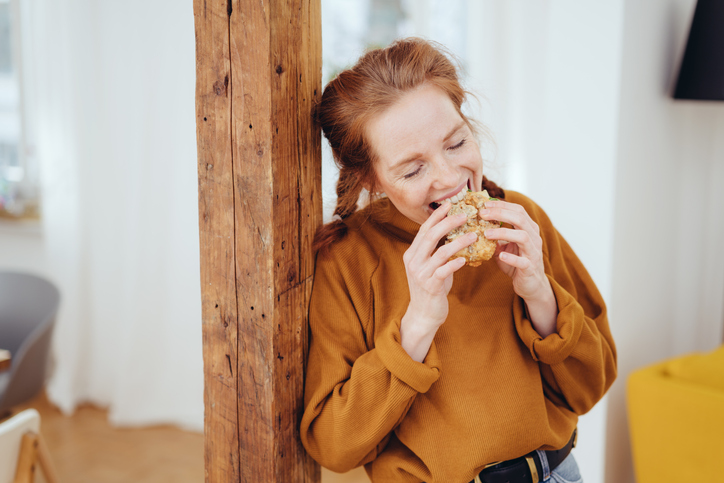
Part Three: Mindful eating in 3 steps – Bring awareness to mealtimes and address your poor eating habits…
1. RECONNECT WITH HUNGER
As an experiment, stop eating between meals. Many of us have fallen into unhelpful patterns of grazing all day, eating leftovers from the children’s plates or doing a 4pm coffee run and grabbing a cake while we’re at it. We have forgotten what proper hunger feels like. ‘If you are not hungry when you start eating, it’s difficult to know when you are full,’ says psychologist Cinzia Pezzolesi. ‘You need to notice when hunger disappears and what fullness feels like. Mindfulness helps you reconnect with the natural self-mechanisms that we tend to ignore when we are trying to control our food intake.’
2. NOTICE HOW DIFFERENT FOODS MAKE YOU FEEL
The next time you find yourself overindulging in unhealthy food, pay attention to what your body is telling you. ‘Ask yourself, do I feel good after eating this item? Or is what you’re experiencing what I call “the taste of disappointment”, asks Pezzolesi,‘when you just know, even as you are eating, that you are going to feel bad afterwards, perhaps even guilty? There is a fine line between something that tastes delicious and feeling that you have overdone it, which leads to feeling bad about it,’ she says.
3. EAT WITH FULL ATTENTION
‘The practice of mindful eating embraces the idea that you can eat anything you want, when you want, as long as you are connected with the experience. That means putting away your phone, turning off the TV and staying present with how the meal is affecting all five of your senses. Afterwards, consider how your body feels. You might be encouraged to make a different choice next time, such as choosing to eat only a small piece of cake because you know that if you eat more, you won’t feel great. Or you might eat the same way the following day… It’s the difference between restriction and choice,’ says Pezzolesi.
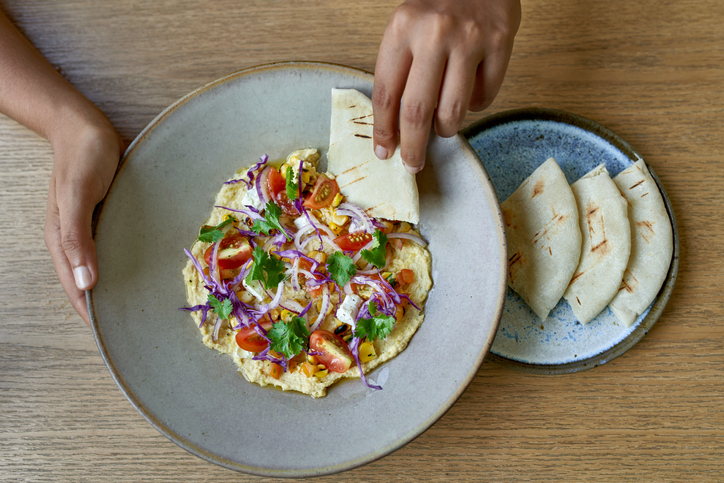
Part Four: What unmet need is being fulfilled by food?
If you still feel an emotional drive to consume certain foods, it’s time to conduct a little self-inquiry to uncover what else might be going on in your relationship with food, and whether your eating habits are serving you well.
‘When clients come to me in this situation, I ask them – what need do you think your habit is meeting?’ says nutritionist Laura Thomas. ‘That need might be that you are living through a global pandemic right now and that is tough. So, food might be offering you something valuable – comfort, pleasure, joy, safety or a sense of connection. Just reframing what you’re doing can take the sting out of it,’ she says.
But identifying the source of your emotional discomfort is only half the solution. The other aspect is to look at your psychological toolkit for coping. ‘A person might examine their typical response to difficult emotions, and realise that in their toolkit they have Victoria sponge, crisps and biscuits,’ says Thomas. ‘If you haven’t developed alternative tools or skills to get through life’s difficulties, and someone tells you that you must remove those foods, what are you left with? Food, in this instance, is serving an important need. It’s not helpful to tell someone they have to stop the behaviour that is making them feel better.’
A more useful response is to develop new, non-food-based coping strategies alongside comfort food. It’s about broadening the range of options available to you. ‘Ask yourself, what other tools could you add? Going for a walk, phoning a friend, meditation or therapy, if appropriate, and integrate food as one of several resources,’ says Thomas. ‘Also, learn to see that comfort eating is a useful response. It is communicating that you have an emotional need that requires soothing. Recognise that eating may be the best tool you have to meet that need right now and give yourself some compassion and acceptance. There is nothing to feel guilt and shame about!’ she adds.
Refreshingly, Thomas believes that eating is a form of self-care, and an affordable one at that. ‘The term self-care has been hijacked by capitalism,’ she observes, referring to the fact that expensive spas and complicated juice cleanses now use the phrase as a marketing strategy. ‘Meanwhile, a packet of biscuits costs about a quid. There is no more fundamental way of caring for ourselves than feeding ourselves and nourishing our souls, as well as the cells in our bodies.’
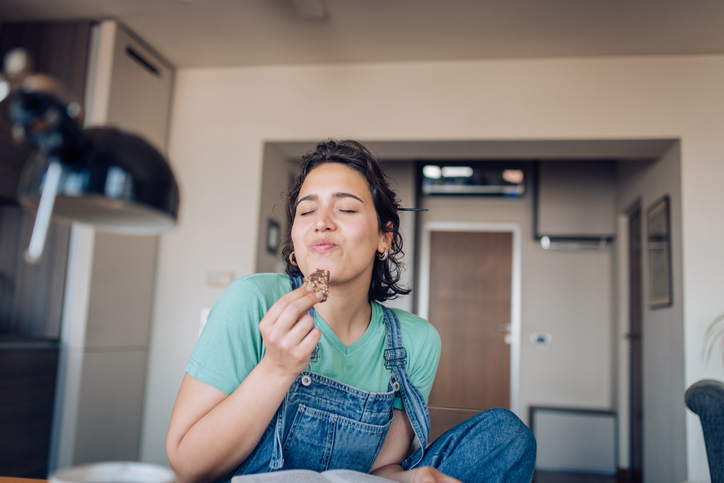
Part Five: The 4 types of eating – why and how we do them
In her wellness practice, which integrates the wisdom of Chinese medicine, holistic and intuitive health coach Kit Yoon breaks down the main ways we consume our food.
“In lockdown, we experienced fear, uncertainty and unease, as well as many other negative emotions. It’s no wonder people turned to food for comfort, connection and relief. Where emotional eating goes awry is when we judge ourselves over it – because the more criticism we heap upon ourselves, the more self-sabotage ensues. Acceptance that it is a normal to eat emotionally sometimes will stop the pattern of self-criticism and self-sabotage.”
Kit Yoon’s ‘four types of eating’ may offer clarity on how you eat:
Part Six: Case Study
“I stopped denying myself and made friends with food” – Kirsty Ketley, 40 is a Nanny and Consultant from Surrey
“After decades of self-punishment and a negative body image, a reader found harmony – and realised that love, laughter and treats go together
Saturday nights mean snacks in front of the TV in our house. Our children, Ella, eight, and Leo, four, are allowed to stay up late with my husband, Stuart, and me for the big event – with crisps and popcorn! This family time became the highlight of our weekends during the grind of the pandemic.
Until the first lockdown, I would forgo the treats while the family indulged – or feel guilty if I joined them. As a trained nanny and parenting consultant, I understood child nutrition and knew that everything in moderation was the key to a healthy life, balanced with plenty of physical activity. I tried to instil this sensible attitude in my clients, who fretted about only serving salt- and sugar-free food to their offspring. Yet, for most of my adulthood, I had failed to apply my knowledge in my own life. I grew up in Derbyshire in the 1980s. My parents weren’t strict about what we ate, but our meals were home-cooked and portions moderate. However, by the time I hit my teens, the diet industry was everywhere. Slimming shakes and self-denial were in vogue, while the so-called perfect female form was waif-like model Kate Moss.
As a girl with a naturally larger chest and hips, and the first of my friendship group to hit puberty, I was self-conscious about my body, even as the Spice Girls were liberating women with ‘girl power’.
I was a keen cross-country runner and extremely fit, but guilt slowly attached itself to certain foods. This got worse when I started working in a nursery and my colleagues were constantly counting calories.
I loved eating out but started to worry about what people would think if I ordered pudding, although I was a healthy size 12 and ate sensibly. The reality was that no one cared and, looking back, I feel sad that I denied myself the pleasure of certain foods for so long. When my daughter was born prematurely in 2013, I suffered from postnatal depression and I stress-ate to cope. With my second pregnancy, I developed gestational diabetes and had to follow a strict diet, which meant that I actually lost weight during pregnancy.
But it took the pandemic to make me reassess my relationship with what I ate and finally let go of negative associations with certain foods. Meals became a way to create structure in our weeks, fill time and feel happy amid the uncertainty and chaos in the world. When my work dried up during lockdown, Ella and I baked cakes and shared our recipes on social media.
Stuart and I love cooking and we enjoyed meals as a couple whenever we could. If he made a rich chicken pie, I stopped worrying about the creamy sauce and puff pastry and just enjoyed it.
My main revelation in finding balance was about being active. The restrictions meant I wasn’t running around in my busy job any more and walks were limited to strolls at a child’s pace. I realised that feeling unhealthy and sluggish was linked to being sedentary and had little to do with whether I denied myself pudding! This epiphany means I’m trying to move more and worry less. Since life has opened up again, longed-for reunions with loved ones have been a feast of laughter, good food and wine. Life’s too short to skimp on the crisps!”
Kirsty is the owner of parenting consultancy auntiekschildcare.co.uk
Words: Alex Lloyd
NEED MORE? GET FREE ONLINE COACHING ON ‘HOW TO STOP EMOTIONAL EATING’
In our free four-week coaching course for subscribers, Dr Julie Leoni, author, educator and researcher will guide you through an indepth look at emotional eating, and help you begin to understand why you comfort eat in order to create healthier habits which help you deal with your emotions without using food, and stay healthy while you do it! If you’re a subscriber, get access now for free here: How to Stop Emotional Eating | Psychologies.
To subscribe to Psychologies and get access to this coaching programme click here.









